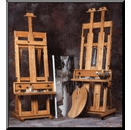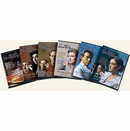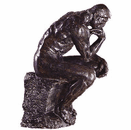Splitting Hairs: Types of Paintbrush Hairs and Bristles
Splitting Hairs: Types of Paintbrush Hairs and Bristles
Choosing a paintbrush can be overwhelming. Not only do paintbrushes come in all different shapes, sizes and configurations, the hairs that make up the bristles affect the performance of the brush.
The hairs from the tail of a sable marten are known for their softness, flexibility and strength. They taper naturally forming a point. The Kolinsky sable is considered the ultimate hair for watercolor paintbrushes.
Squirrel hair is less expensive than sable and tends to be soft with little spring to it. Larger squirrel brushes are preferred over the smaller ones because the larger mass of hair gives it more support.
Camel hair brushes are misnamed because they aren’t necessarily made from camel hair as it is considered too wooly. They are usually made from other soft animal hair.
Ox hair brushes are made from long, springy and strong ox hair.
Goat hair is often used in Chinese Brush painting and calligraphy due to its ability to form a good point.
Course pony hair does not form a good point and is most often found in less expensive brushes.
The bristles from a hog’s back are hard, strong and springy making them one of the ultimate choices for a hard, bristled paintbrush. Their natural split-ends allow them to hold more paint. Hog bristle brushes are most often used for oils and acrylics.
Soft paintbrushes such as sable and squirrel are best for detailed work because they form a sharp point. They are ideal when using thin paint that spreads easily. Hard paintbrushes such as hog hair are great for thicker paints and making brush strokes in the paint.
Synthetic fiber paintbrushes are much less expensive than their natural hair counterparts. Today’s modern synthetics offer excellent results at a more affordable price. Whatever the medium and the budget, there’s a paintbrush that’s right for the job.
www.MadisonArtShop.com
This short article describes the different types of bristles found in today's artist paintbrushes.
Choosing a paintbrush can be overwhelming. Not only do paintbrushes come in all different shapes, sizes and configurations, the hairs that make up the bristles affect the performance of the brush.
The hairs from the tail of a sable marten are known for their softness, flexibility and strength. They taper naturally forming a point. The Kolinsky sable is considered the ultimate hair for watercolor paintbrushes.
Squirrel hair is less expensive than sable and tends to be soft with little spring to it. Larger squirrel brushes are preferred over the smaller ones because the larger mass of hair gives it more support.
Camel hair brushes are misnamed because they aren’t necessarily made from camel hair as it is considered too wooly. They are usually made from other soft animal hair.
Ox hair brushes are made from long, springy and strong ox hair.
Goat hair is often used in Chinese Brush painting and calligraphy due to its ability to form a good point.
Course pony hair does not form a good point and is most often found in less expensive brushes.
The bristles from a hog’s back are hard, strong and springy making them one of the ultimate choices for a hard, bristled paintbrush. Their natural split-ends allow them to hold more paint. Hog bristle brushes are most often used for oils and acrylics.
Soft paintbrushes such as sable and squirrel are best for detailed work because they form a sharp point. They are ideal when using thin paint that spreads easily. Hard paintbrushes such as hog hair are great for thicker paints and making brush strokes in the paint.
Synthetic fiber paintbrushes are much less expensive than their natural hair counterparts. Today’s modern synthetics offer excellent results at a more affordable price. Whatever the medium and the budget, there’s a paintbrush that’s right for the job.
www.MadisonArtShop.com
This short article describes the different types of bristles found in today's artist paintbrushes.
Copyright © 2002-2025 Madison Art Shop™ LLC. All Rights Reserved.

















